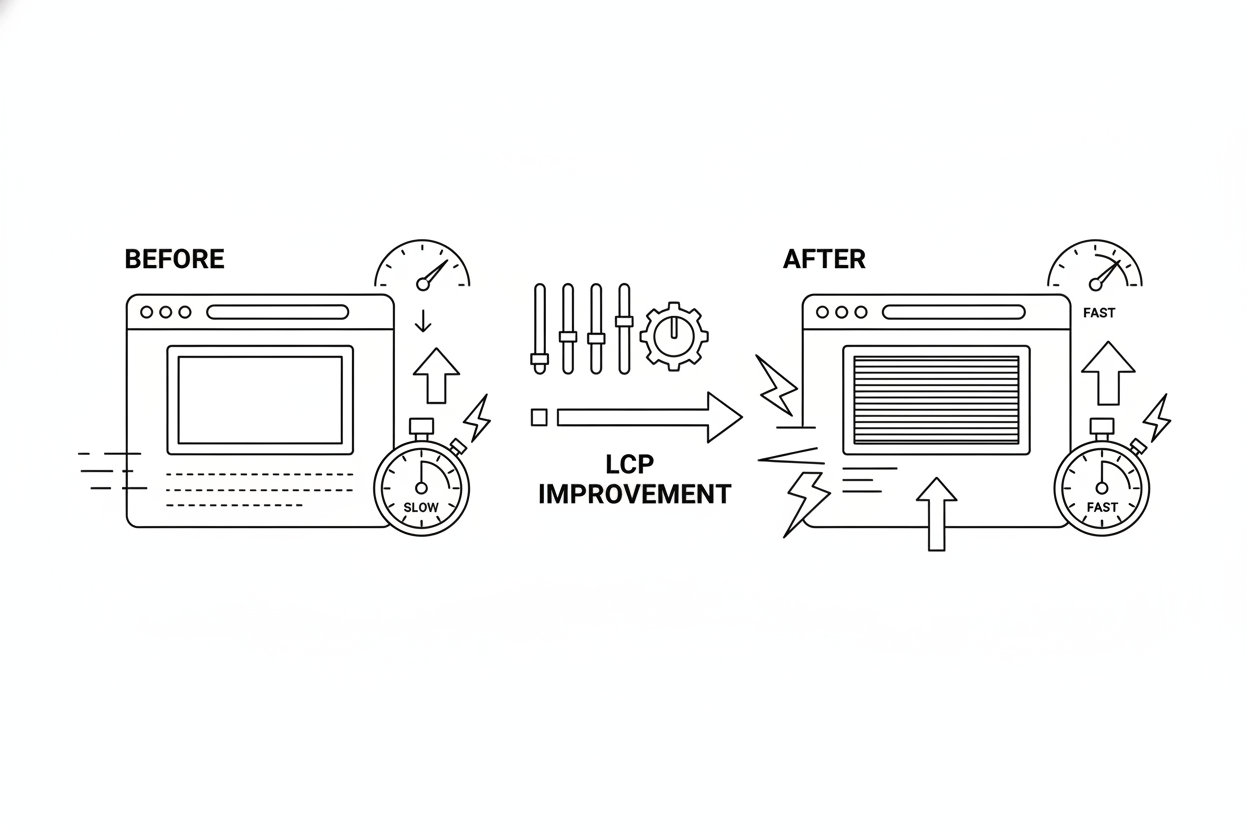A poor Largest Contentful Paint (LCP) score is one of the most common and damaging Core Web Vitals issues. It’s a direct signal to Google and your users that your page feels slow, and it's a primary symptom of technical debt that can throttle your crawl budget.
As we covered in our Ultimate Guide to Core Web Vitals, LCP measures how long it takes for the largest content element (usually a hero image or a large text block) to become visible within the viewport. A "Good" score is under 2.5 seconds.
This guide provides a practical, 5-step workflow to diagnose the cause of your poor LCP and apply the correct technical fixes.
Chapter 1: The 4 Components of LCP (The Waterfall)
Before you can fix LCP, you must understand that it's not one single metric. It's the final result of a four-part chain reaction. You must identify which part of the chain is broken.
- Time to First Byte (TTFB): The time it takes for your server to send back the first byte of HTML after your browser requests it. This is pure server/backend speed.
- Resource Load Delay: The time it takes the browser, after receiving the HTML, to discover and start loading the LCP element. This is often delayed by render-blocking code (CSS/JS).
- Resource Load Time: The time it actually takes to download the LCP element (e.g., the time to download that 2MB hero image).
- Element Render Delay: The time after the element has finished downloading until it is fully rendered on the screen.
A poor LCP is almost always caused by a major bottleneck in one of these four phases.
Chapter 2: The 5-Step Workflow to Diagnose and Fix LCP
Step 1: Identify Your LCP Element (The "What")
You can't fix what you haven't identified.
- Go to PageSpeed Insightsand enter your URL.
- Scroll down to the "Diagnostics" section.
- Find the "Largest Contentful Paint element" audit. This will show you exactly what element (e.g., , ) is being measured as your LCP.
Step 2: Diagnose Your Core Bottleneck (The "Why")
Now, use the "Waterfall" from Chapter 1. Look at your PageSpeed Insights report:
- Is the "Time to First Byte (TTFB)" audit failing (marked in red)? If yes, your bottleneck is the server. Your LCP can never be fast if your server is slow.
- Is your TTFB fast, but the LCP is still slow? And is your LCP element an image? This means your bottleneck is likely Resource Load Time.
- Is the "Eliminate render-blocking resources" audit failing? This means your bottleneck is Resource Load Delay.
Step 3: Fix Server Bottlenecks (TTFB)
If your TTFB is poor (e.g., over 800ms), no amount of frontend optimization will matter.
- Enable Caching: Implement server-side caching or a CDN (Content Delivery Network) to serve static HTML.
- Optimize Your Database: Slow database queries are a common cause of high TTFB.
- Upgrade Your Hosting: Your cheap shared hosting plan may be the problem.
Step 4: Fix Render-Blocking Resources (Load Delay)
If your LCP element is being delayed by other code, you need to re-prioritize.
- Defer or async non-critical JavaScript: Stop scripts (like analytics, chat widgets) from blocking the main thread.
- Inline Critical CSS: Identify the absolute minimum CSS needed to render the content "above the fold" and place it directly in the of your HTML.
- Preload Your LCP Image: If your LCP element is a hero image that's discovered late by the browser, you can give the browser a "hint" to load it immediately. Add this to your :HTML
Step 5: Fix the Element Itself (Load Time)
This is the most common fix. If your LCP element is a giant, unoptimized image, you must fix it. This is where our full guide to image optimizationis critical.
- Compress Your Image: Use a tool like Squoosh or TinyPNG to reduce the file size.
- Use Modern Formats: Convert your image from JPEG/PNG to a next-gen format like WebP or AVIF. These formats offer superior quality at a much smaller file size.
- Serve Responsive Images: Use the element or the srcset attribute to serve different image sizes for mobile and desktop. A mobile user should never download a 2000px-wide desktop image.
Chapter 3: Expert Insight & Real-World Example
Expert Insight from seopage.ai: *"We analyzed a PSEO client whose LCP was over 6.0 seconds, despite a fast server. Their LCP element was a hero image.The Problem: The image was a 2.1MB PNG file. It was also being "lazy-loaded" by a JavaScript plugin. This meant the browser couldn't even start downloading the most important element on the page until after the JavaScript had loaded.The Fix:
- We converted the image from PNG to WebP, reducing its size from 2.1MB to 280KB.
- We removed lazy-loading from that specific image. (You should never lazy-load your LCP element).
- We added a tag to the .
The Result: The LCP score dropped from 6.1s to 1.9s (a "Good" score), passing Core Web Vitals and improving the site's overall Crawl Health."*
Conclusion: LCP is an Engineering Problem
Improving LCP is a technical, systematic process. By using this 5-step workflow, you can move from "our site feels slow" to "our LCP is slow because the Resource Load Delay is high." This diagnostic precision is the key to an effective fix.
By optimizing your LCP, you are sending a strong positive signal to both your users and Google, ensuring a better user experience and a healthier foundation for all your SEO efforts.

